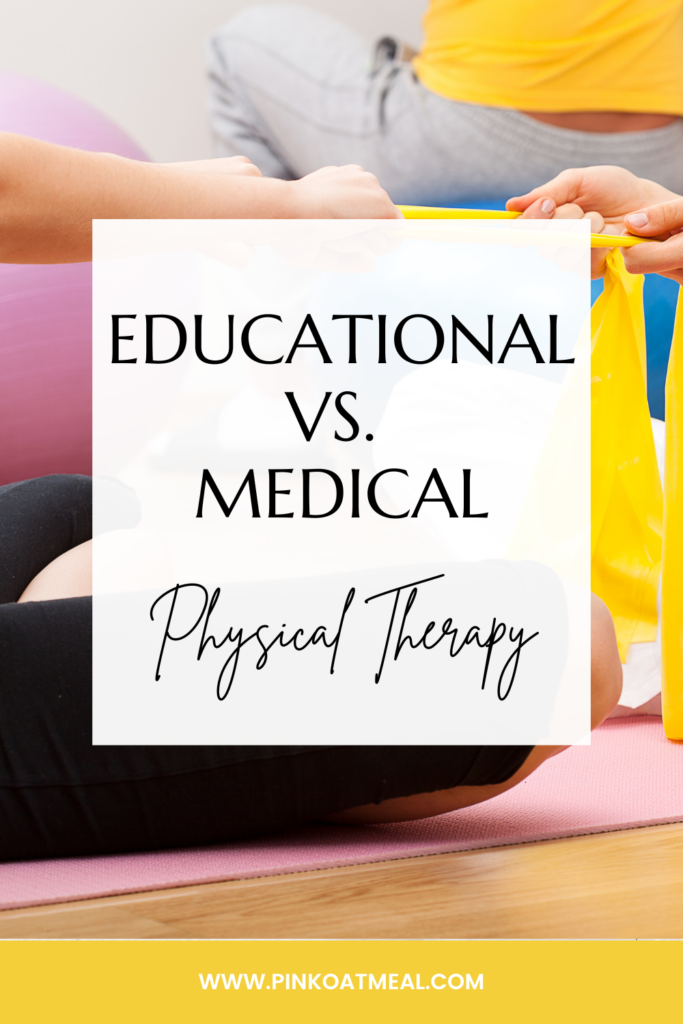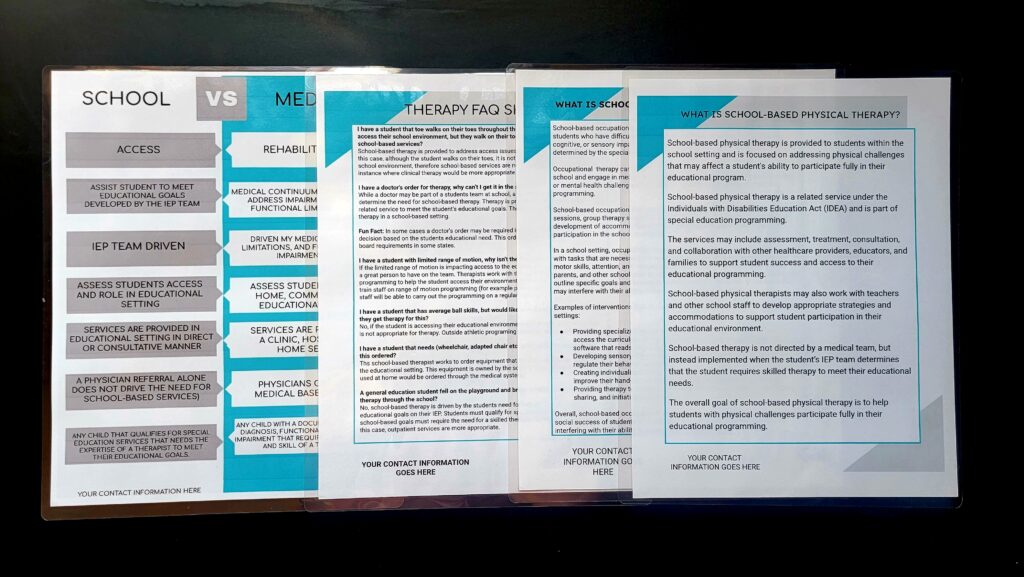What is the difference between the educational vs. medical physical therapy? This question is common and in this blog post we are going to try to break it down for you!
All therapists whether they are working in the educational or medical model work to adhere to licensure laws and professional standards. They all work to use evidence-based practices in their interventions and decision making. Both work to help their kiddos accomplish their goals in their given setting. All therapists are collaborative team members and families. In both settings, progress and outcomes are tracked and measured using appropriate testing in that given setting. In both settings, services are provided based on the needs of the child.

School-Based Physical Therapy
Let’s start with how school-based physical therapy began.
The Individuals with Disabilities Education Act (IDEA) is a law that makes available a free appropriate public education to eligible children with disabilities throughout the nation and ensures special education and related services to those children.
An IEP is part of special education law, or the Individuals with Disabilities Education Act (IDEA).
An IEP is an Individual Education Plan. Essentially, it lays out the program of special education instruction, supports and services kids need to make progress and succeed in school. For some kiddos, skilled physical therapy may be needed to help meet those educational needs. This may include physical therapy as a direct or consultative service.
Each education plan is individually designed to meet a child’s exact needs. The term IEP is also used to refer to the written plan that directs specific types of help the child will get.
A school-based physical therapists service will be written into that child’s IEP. The IEP will have service time, goals/objectives that a school-based therapist may be associated with, and accommodations that the therapist may play a role in.
Educational vs. Medical Physical Therapy
School physical therapy typically refers to physical therapy services provided to school-aged children in an educational setting. This may include evaluations, interventions, and consultations related to the child’s ability to participate in school activities. Educational physical therapy may also involve working with teachers and other school personnel to develop strategies and programming to meet the child’s educational goals.
On the other hand, medical physical therapy typically refers to physical therapy services provided in a clinical setting, such as a hospital, outpatient clinic, or private practice or even in home. Medical physical therapy may involve treating a wide range of conditions and injuries, including musculoskeletal pain, neurological disorders, post-surgical rehabilitation, and chronic diseases.
Educational physical therapy is focused on helping students to participate fully in their educational environment. This may include providing assistive devices or modifications to the physical environment to make it more accessible, as well as designing individualized motor skills programs.
Medical physical therapy, on the other hand, is focused on impairments and functional limitations that affect the child’s ability to perform daily activities at home, in the community and in daily life. This can include rehabilitation after surgery, recovery from sports injuries, or treatment for chronic pain conditions. Medical physical therapists work with patients to develop customized treatment plans that include exercises, manual therapy, and other techniques to improve strength, flexibility, and function.
While there are some similarities between school and medical physical therapy, the goals and focus of each are quite different. School physical therapy is primarily focused on promoting inclusion and accessibility for students with disabilities in the educational setting, while medical physical therapy is focused on medical continuum and addressing those impairments and functional limitations.
EDUCATIONAL = ACCESS
MEDICAL = REHABILITATION
School Therapy vs. Medical Therapy Doctors Orders
In a school-setting, a physician order itself does not drive the need for school-based services.
While a doctor may be part of a students team at school, a doctor’s order alone does not determine the need for school-based therapy. Therapy is provided in the school as a related service to meet the student’s educational goals. The IEP drives the need for therapy in a school-based setting.
Fun Fact: In some cases a doctor’s order may be required in addition to the team driven decision based on the students educational need. This order is due to therapy licensing board requirements in some states.
In a medical setting, a physicians order is accepted as a need to evaluate the kiddo and address any impairments and physical limitations found in the evaluation and providing a continuum of medical care.
Educational vs. Medical Resources
There are several resources out there that you can share with others to better help them understand the difference between the educational model and medical model of physical therapy
PINK OATMEAL HANDOUTS – All-Access Pass members have access to several different handouts related to the educational versus medical model.

APTA FACT SHEET – This is a great resource that breaks down the difference between the educational and medical model.
